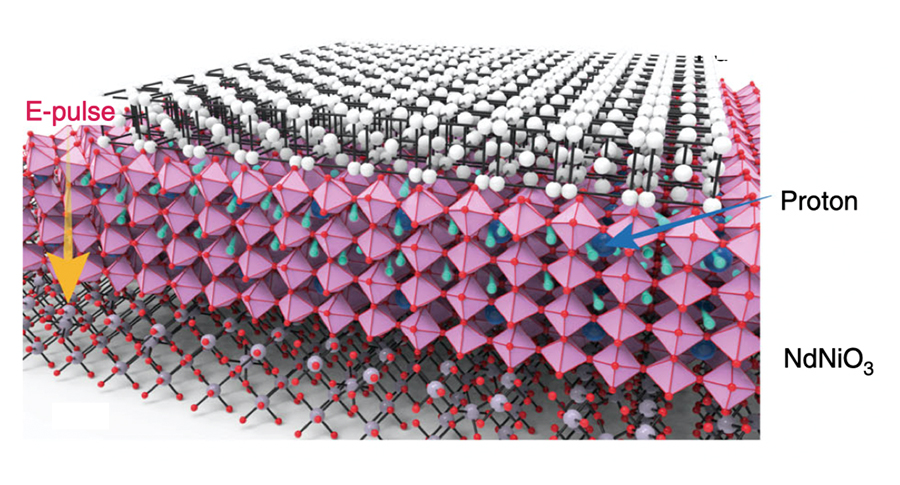May 11 2020
The aim of many researchers across the world is to develop a neuromorphic computer—one that is motivated by and functions just like a human brain.
 A schematic figure of the perovskite nickelate. Applying electric field pulses can move the protons in the lattice, thus modulating the device resistance in a systematic manner. Image Credit: Figure courtesy of Q-MEEN-C research team.
A schematic figure of the perovskite nickelate. Applying electric field pulses can move the protons in the lattice, thus modulating the device resistance in a systematic manner. Image Credit: Figure courtesy of Q-MEEN-C research team.
Supported by the U.S. Department of Energy (DOE), collaborative research teams are exploring ways to use quantum materials to create such an energy-efficient device. But to accomplish this type of artificial intelligence (AI), the scientists should produce manufactured synapses—that is, structures in the brain that allow learning and memory over extended periods of time.
Q-MEEN-C—the DOE-supported Energy Frontiers Research Center—is heading this research effort at the University of California San Diego (UC San Diego).
In the latest study published in the Nature Communications journal, physicists Alex Frano, Oleg Shpyrko, and Ivan Zaluzhnyy from UC San Diego, together with colleagues from Argonne National Laboratory, Purdue University, Brookhaven National Laboratory, and the University of Louisville, Kentucky, explained how the synapses of the brain encode memory by acclimatizing their “weight,” or resistance, to electrical stimuli.
While the resistance of a synapse decreases or increases with respect to stimuli during the life of its host, it will not modify to the point of fragmenting the neural circuit. The reason is evolution created a mechanism, called a branch, to maintain the stability of the circuit.
However, if the stimuli are altered in duration, intensity, or pulse, the trajectory transforms into another branch. Following many of these stimuli variations, the synaptic weight trajectory contains several branches and therefore several “learned” states—enabling a lifetime of learning for the host—some kind of tree of knowledge.
Just like decision-tree algorithms found in math, the tree-like structure for preserving memory has been unfeasible to simulate in actual materials. However, in the study titled, “Perovskite Neural Trees,” the national team of researchers showed the potential to produce tree-like trajectories of a material’s electrical resistance.
We were so surprised to discover how the resistance trajectory of our devices mimics those of actual brain synapses. The ability to make ‘neural trees’ or ‘decision trees’ in hardware is very exciting.
Alex Frano, Physicist, University of California San Diego
In their article, the researchers explained that it was difficult to identify the true materials that are capable of hosting numerous states. Each of the said states is capable of learning and can be exclusively detected electrically. But the researchers successfully resolved these challenges by identifying a material that shows these characteristics.
We show they can operate safely without catastrophic breakdown, and we demonstrate that they can learn. The results open up a new dimension of safe hardware for AI and neuromorphic computing.
Alex Frano, Physicist, University of California San Diego
In their analysis, the scientists implemented atomic-scale control over the migration of protons in a nickel-oxide thin film exposed to nanosecond electric pulses.
The materials’ resistance is extremely susceptible to electric field pulses (changes occur in the resistance when electric field pulses are applied) and proton doping (that is, the addition of one proton for each chemical formula results in approximately ~10 orders of magnitude change in electrical resistance). The former takes place across the proton migration in relation to the electric field.
At UC San Diego, the researchers applied a new experimental method of directing an X-ray beam down to 20 nm, so they can possibly “visualize” the way the protons travel around the sample as they produce new tree branches.
The scientists stated that the quantum mechanical amplification effect caused by the proton drift allows a large number of dynamically programmable tree memory states using electrical pulses. Collectively, such aspects form the groundwork for neuromorphic hardware synapses.
Our team was excited to literally ‘see’ how the migration of protons inside the material gives it the chance to develop a resistive trajectory, or ‘branch. Furthermore, different pulses reorganize the protons in different configuration, yielding another branch. The sheer ability to detect the migration of light hydrogen protons at the nanometer scale was incredibly exciting to us.
Alex Frano, Physicist, University of California San Diego
The effect of these findings covers a wide range of fields.
“On the one hand, these can be now implemented into architectures of neuromorphic hardware. For instance, software/hardware hybrid systems can now be designed. On the other hand, now that we understand better the physical mechanism by which we can create these artificial neural trees, we can explore other materials that can allow us to do that,” added Frano.
“Finally, the technique we developed to visualize the motion of protons, we can use it to understand other relevant phenomena like electromigration and phase separation in materials,” Frano concluded.
The research was supported by the Gilbreth Fellowship, College of Engineering at Purdue University; AFOSR (FA9550-19-1-0351); ARO W911NF1920237; the “Quantum Materials for Energy Efficient Neuromorphic Computing,” an Energy Frontier Research Center financially supported by the U.S. Department of Energy (DOE), Office of Science, Basic Energy Sciences (award no. DE-SC0019273, DESC0001805 and contract no. DE-AC02-06CH11357).
The study was also supported by the National Energy Research Scientific Computing Center (NERSC)—a U.S. Department of Energy Office of Science User Facility (contract no. DE-AC02-05CH11231), and the U.S. DOE Office of Science managed by Brookhaven National Laboratory (contract no. DE-SC0012704).